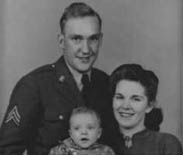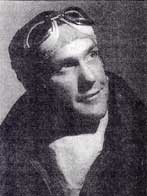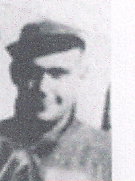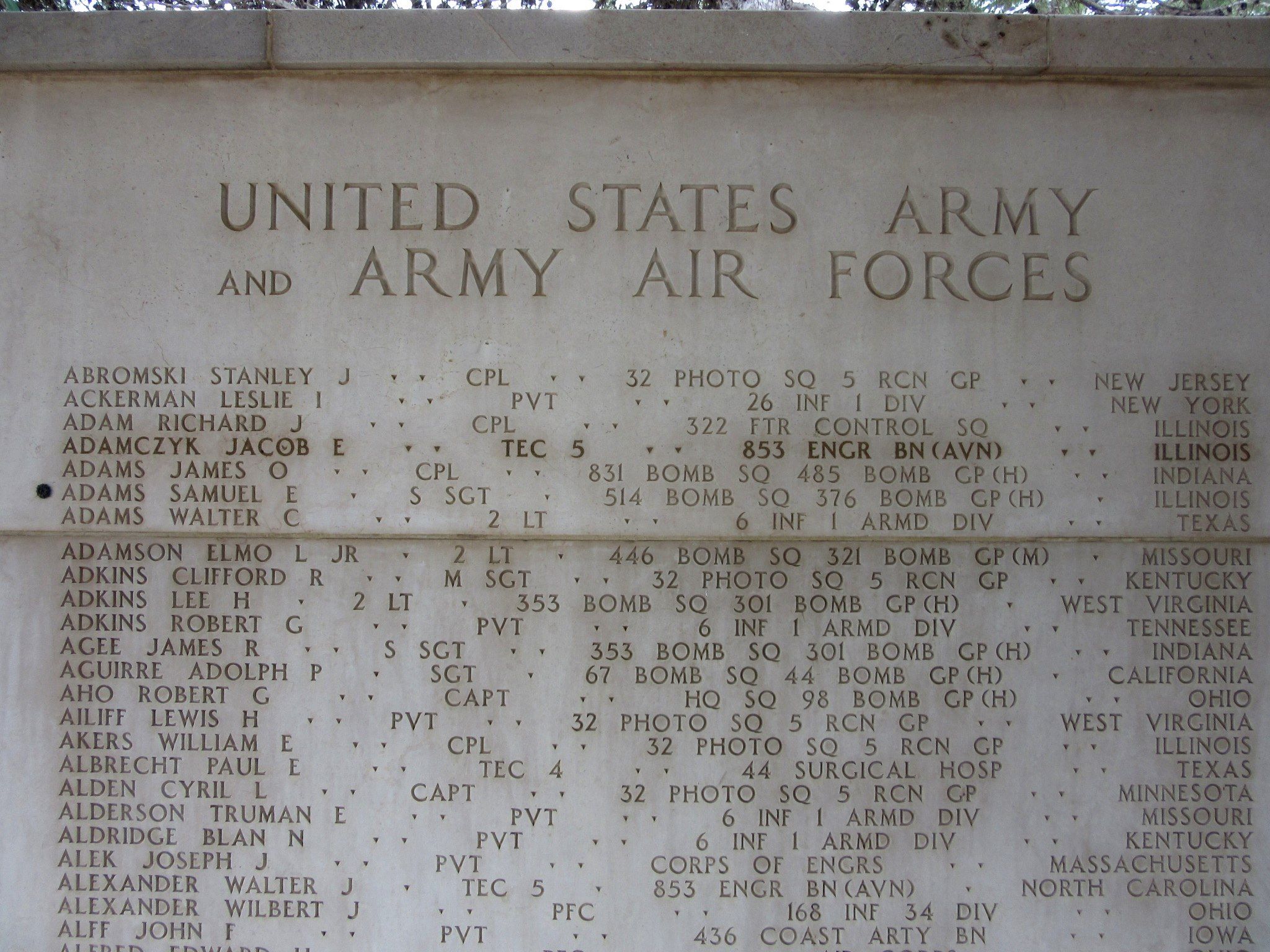Samuel served as a Staff Sergeant and Tail Gunner on B-24D #41-24301 "Lady Be Good", 514th Bomber Squadron, 376th Bomber Group, Heavy, U.S. Army Air Corps during World War II.
Sam married Dorothy Mae Sherman on October 25, 1941 in Kahoka, Missouri. They had a son, Michael. They resided in Woodford County, Illinois prior to the war. Samuel enlisted in the Army on February 12, 1942 at Camp Grant, Illinois. He was noted, at the time of his enlistment, as being employed in construction and also as being married. He tested for and was accepted into the Air Corps division of the Army.
On April 4, 1943, B-24D #41-24301 (Lady Be Good) took off from their base in Libya, with a crew of 9, on a high altitude bombing mission over Naples Harbor, Italy. Without smaller fighter plane protection, all communication had to be silenced until the mission had been completed, so as to avoid being detected by German night fighter planes. Once the Lady Be Good left base, she was never heard from again. Samuel and the entire crew were declared "Missing In Action".
Samuel was posthumously awarded the Air Medal and the Purple Heart; service # 36318060.
In May of 1958 during an aerial survey by a British oil exploration team, they spotted what looked like a World War II era plane. In March 1959 a ground geological team visited the aircraft and it was confirmed to be The Lady Be Good. The crew, except for SSgt. Moore, was eventually recovered in March of 1960.
Airmen who perished on B-24D #41-24301:
Adams, Samuel E. ~ S/Sgt, Tail Gunner, IL
Hatton, William J. ~ 1st Lt, Pilot, NY
Hays, DP ~ 2nd Lt, Navigator, MO
La Motte, Robert E. ~ T/Sgt, Radio Operator, MI
Moore, Vernon L. ~ S/Sgt, Gunner, OH
Ripslinger, Harold J. ~ T/Sgt, Engineer, MI
Shelley, Guy E., Jr. ~ S/Sgt, Gunner, PA
Toner, Robert F. ~ 2nd Lt, Co-Pilot, MA
Woravka, John S. ~ 2nd Lt, Bombardier, OH
2nd Lt. Robert F. Toner kept a diary, that was found in the desert, concerning this crash and what happened to the crew. Life Magazine featured the diary in one of their issues ~ the entries read:
April 4, 1943
Naples: 28 planes. Things pretty well mixed up. Got lost returning, out of gas, jumped, landed in desert at 2 in morning. No one badly hurt. Can't find John, all others present.
(April 5, 1943)
Monday
Start walking NW. Still no John. A few rations, 1/2 canteen of water, 1 cup full per day. Sun fairly warm, good breeze from N.W. Nite very cold. No sleep. Rested and walked.
(April 6, 1943)
Tuesday
Rested at 11:30, sun very warm, no breeze. Spent P.M. in hell. No planes, etc. Rested until 5 P.M. Walked and rested all night, 15 min. on, 5 off.
(April 7, 1943)
Wednesday
Same routine, everyone getting weak, can't get very far, prayers all the time, again P.M. very warm, hell. Can't sleep. Everyone sore from ground.
(April 8, 1943)
Thursday
Hit sand dunes, very miserable, good wind but continuous blowing of sand, everybody now very weak, thought Sam and Moore were all gone. LaMotte's eyes are gone, everyone else's eyes are bad. Still going N.W.
(April 9, 1943)
Friday
Shelley, Rip, Moore separate and try to go for help, rest of us all very weak, eyes bad. Not any travel, all want to die, still very little water, nites are about 35°, good N. wind, no shelter, 1 parachute left.
(Apr 10, 1943)
Saturday
Still having prayer meetings for help. No signs of anything, a couple of birds, good wind from N. Really weak now, can't walk, pains all over, still all want to die. Nights very cold, no sleep.
(April 11, 1943)
Sunday
Still waiting for help, still praying, eyes bad, lost all our wgt., aching all over, could make it if we had some water, just enough left to put our tongue to, have hope for help very soon, no rest, still same place.
(April 12, 1943).
Monday
No help yet. Very cold night.
--------------------------------------------------------------------------------------------------------------------
"The dauntless courage and tenacity of these men in the face of danger, their suffering and unthinkable deprivation, will remain a high point of human achievement against the most severe adversities. The men of the Lady Be Good have given desert survival schools a new gauge with which to indoctrinate their students; a measuring stick that may save other lives."
- excerpt from Mystery Bomber of World War II The Lady Be Good by Dennis E. McClendon, Lt. Col. USAF, Ret..
Samuel served as a Staff Sergeant and Tail Gunner on B-24D #41-24301 "Lady Be Good", 514th Bomber Squadron, 376th Bomber Group, Heavy, U.S. Army Air Corps during World War II.
Sam married Dorothy Mae Sherman on October 25, 1941 in Kahoka, Missouri. They had a son, Michael. They resided in Woodford County, Illinois prior to the war. Samuel enlisted in the Army on February 12, 1942 at Camp Grant, Illinois. He was noted, at the time of his enlistment, as being employed in construction and also as being married. He tested for and was accepted into the Air Corps division of the Army.
On April 4, 1943, B-24D #41-24301 (Lady Be Good) took off from their base in Libya, with a crew of 9, on a high altitude bombing mission over Naples Harbor, Italy. Without smaller fighter plane protection, all communication had to be silenced until the mission had been completed, so as to avoid being detected by German night fighter planes. Once the Lady Be Good left base, she was never heard from again. Samuel and the entire crew were declared "Missing In Action".
Samuel was posthumously awarded the Air Medal and the Purple Heart; service # 36318060.
In May of 1958 during an aerial survey by a British oil exploration team, they spotted what looked like a World War II era plane. In March 1959 a ground geological team visited the aircraft and it was confirmed to be The Lady Be Good. The crew, except for SSgt. Moore, was eventually recovered in March of 1960.
Airmen who perished on B-24D #41-24301:
Adams, Samuel E. ~ S/Sgt, Tail Gunner, IL
Hatton, William J. ~ 1st Lt, Pilot, NY
Hays, DP ~ 2nd Lt, Navigator, MO
La Motte, Robert E. ~ T/Sgt, Radio Operator, MI
Moore, Vernon L. ~ S/Sgt, Gunner, OH
Ripslinger, Harold J. ~ T/Sgt, Engineer, MI
Shelley, Guy E., Jr. ~ S/Sgt, Gunner, PA
Toner, Robert F. ~ 2nd Lt, Co-Pilot, MA
Woravka, John S. ~ 2nd Lt, Bombardier, OH
2nd Lt. Robert F. Toner kept a diary, that was found in the desert, concerning this crash and what happened to the crew. Life Magazine featured the diary in one of their issues ~ the entries read:
April 4, 1943
Naples: 28 planes. Things pretty well mixed up. Got lost returning, out of gas, jumped, landed in desert at 2 in morning. No one badly hurt. Can't find John, all others present.
(April 5, 1943)
Monday
Start walking NW. Still no John. A few rations, 1/2 canteen of water, 1 cup full per day. Sun fairly warm, good breeze from N.W. Nite very cold. No sleep. Rested and walked.
(April 6, 1943)
Tuesday
Rested at 11:30, sun very warm, no breeze. Spent P.M. in hell. No planes, etc. Rested until 5 P.M. Walked and rested all night, 15 min. on, 5 off.
(April 7, 1943)
Wednesday
Same routine, everyone getting weak, can't get very far, prayers all the time, again P.M. very warm, hell. Can't sleep. Everyone sore from ground.
(April 8, 1943)
Thursday
Hit sand dunes, very miserable, good wind but continuous blowing of sand, everybody now very weak, thought Sam and Moore were all gone. LaMotte's eyes are gone, everyone else's eyes are bad. Still going N.W.
(April 9, 1943)
Friday
Shelley, Rip, Moore separate and try to go for help, rest of us all very weak, eyes bad. Not any travel, all want to die, still very little water, nites are about 35°, good N. wind, no shelter, 1 parachute left.
(Apr 10, 1943)
Saturday
Still having prayer meetings for help. No signs of anything, a couple of birds, good wind from N. Really weak now, can't walk, pains all over, still all want to die. Nights very cold, no sleep.
(April 11, 1943)
Sunday
Still waiting for help, still praying, eyes bad, lost all our wgt., aching all over, could make it if we had some water, just enough left to put our tongue to, have hope for help very soon, no rest, still same place.
(April 12, 1943).
Monday
No help yet. Very cold night.
--------------------------------------------------------------------------------------------------------------------
"The dauntless courage and tenacity of these men in the face of danger, their suffering and unthinkable deprivation, will remain a high point of human achievement against the most severe adversities. The men of the Lady Be Good have given desert survival schools a new gauge with which to indoctrinate their students; a measuring stick that may save other lives."
- excerpt from Mystery Bomber of World War II The Lady Be Good by Dennis E. McClendon, Lt. Col. USAF, Ret..
Sponsored by Ancestry
Advertisement
Records on Ancestry
Advertisement








